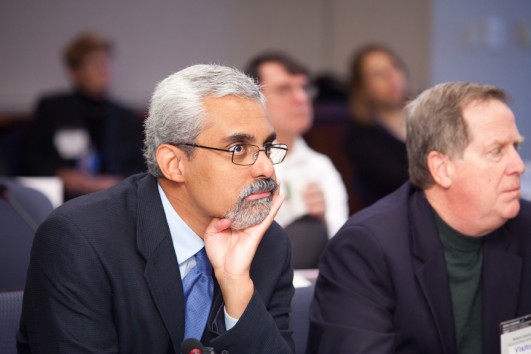A Centralized Down Syndrome Registry and Biobank
Down Syndrome: National Conference on Patient Registries, Research Databases and Biobanks – December 2-3, 2010 – Rockville, MD

Down syndrome researcher Dr. Alberto Costa listens intently at the National Conference on Patient Registries, Research Databases and Biobanks in Rockville, MD.
Down syndrome is the most common cause of developmental disabilities, and the most frequently occurring chromosomal disorder in the United States, representing one in every 691 births. Despite its frequency, Down syndrome receives the least amount of funding of any genetic condition by our National Institutes of Health (NIH). In 2009, NIH allocated only .0006 percent of its $31 billion budget to Down syndrome research. In addition, the funding level of Down syndrome was nearly 75% higher 10 years ago. This is irrefutable evidence of the precipitous de-funding of Down syndrome over the last decade.
In response to this alarming disparity, the Global Down Syndrome Foundation joined the NIH’s Eunice Kennedy Shriver National Institute for Childhood Health and Human Development (NICHD) to co-organize the first “Down Syndrome: National Conference on Patient Registries, Research Databases and Biobanks” in December of 2010.
People with Down syndrome are prone to several major medical conditions (e.g. congenital heart defects, Alzheimer’s) and inexplicable cognitive delay along a large spectrum. A patient registry and the associated research database and biobank organized around Down syndrome would allow caregivers, medical care providers and researchers to identify critical health trends, tabulate the most effective treatments and design clinical trials for potential therapies.
The purpose of our conference was and is:
1. Enable impactful discussions between (a) experts on registry and biobanks and (b) Down syndrome experts who would potentially utilize such a registry and/or biobank.
2. Publish a white paper on a paitient registry and biobanking for Down syndrome that would clearly define conclusions, as well as the important follow-up step.
3. Provide a timeline for follow-up and establish a plan for the Down syndrome patient registry and biobank that has clear funding potential, reasonable consensus on parameters and input from people with Down syndrome and their caregivers across a variety of demographics.
Key discussion topics
Registries
- What are the short-, mid- and long-term goals of a Down syndrome contact registry from the perspective of various stakeholders (parents, medical care providers, researchers, government)?
- What are the individuals’/families’ concerns associated with participating in a Down syndrome research database, and potentially clinical trials, and how should those be addressed? What outlets and informational efforts are needed to encourage participation, and by whom? Will results from studies that use the data be shared with the families?
- What issues might arise relating to privacy and confidentiality of information that will be included in a Down syndrome research database? How should issues of consent/assent/permission be addressed?
- Who would “own” the Down syndrome research database, and how would it be maintained, particularly if the database grows (internationally)? Who funds the database over the longer term? What costs are associated with this? What accountability should there be and to whom?
- What data is essential to include in a Down syndrome research database? What database forums (models) already exist and could be adapted?
Biobanks
- What types of research related to Down syndrome make it essential to have a research resource such as a biobank? Whst tissues would be optimal to collect? What are the challenges with collecting these samples (e.g. procurement, quality control, regulatory issues), and how should these issues be addressed?
- What IRB issues are likely to arise in collecting tissues from individuals with Down syndrome (consent, etc.) and how can those be addressed? How is the information from the samples protected (confidentiality)? Can we learn from existing brain/tissue banks?
- What logistical and technological issues arise during maintenance of a brain and tissue bank, and how should those issues be addressed? What are the costs involved with long-term maintenance of a biobank? Can expansion be accommodated? Should there be a centralized biobank or several regional biobanks?
- What are the best ways to reach out to families regarding donation of tissues to the biobank? Who should conduct that research?

 Experience our inspirational and groundbreaking videos and photos. Our children and self-advocates are beautiful AND brilliant!
Experience our inspirational and groundbreaking videos and photos. Our children and self-advocates are beautiful AND brilliant! Make sure your local Representatives are on the Congressional Down Syndrome Task Force.
Make sure your local Representatives are on the Congressional Down Syndrome Task Force.